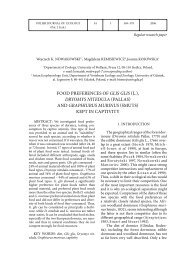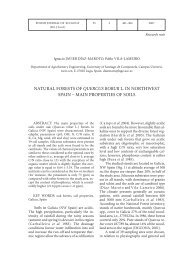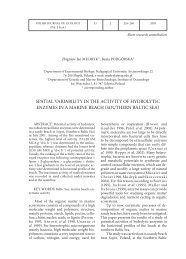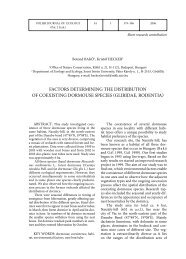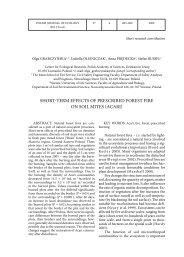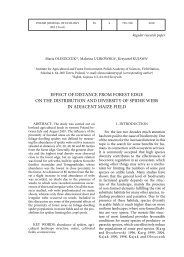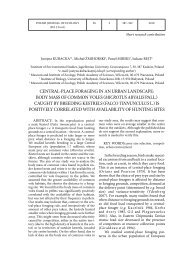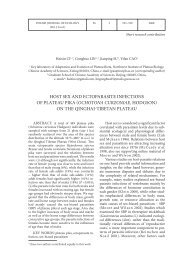Article - Polish Journal of Ecology
Article - Polish Journal of Ecology
Article - Polish Journal of Ecology
Create successful ePaper yourself
Turn your PDF publications into a flip-book with our unique Google optimized e-Paper software.
POLISH JOURNAL OF ECOLOGY<br />
(Pol. J. Ecol.)<br />
59 4 677–686 2011<br />
Regular research paper<br />
Kinga KOSTRAKIEWICZ<br />
Department <strong>of</strong> Plant <strong>Ecology</strong>, Institute <strong>of</strong> Botany, Jagiellonian University,<br />
Lubicz str. 46, 31–512 Kraków, Poland, e-mail: kinga.kostrakiewicz@uj.edu.pl<br />
THE EFFECT OF GAPS SIZE ON COLONIZATION PROCESS<br />
IN MOLINIETUM CAERULEAE MEADOWS<br />
WITH DIFFERENT HABITAT CONDITIONS<br />
ABSTRACT: The disturbances defined as<br />
an external factor causing biomass removal are a<br />
key component <strong>of</strong> all ecosystems. In phytocenoses<br />
with a continuous vegetation cover and a large<br />
proportion <strong>of</strong> perennial plants the fine-scale disturbances<br />
create gaps, which are the temporary<br />
competitor-free microsites suitable for plant recruitment.<br />
The investigations <strong>of</strong> natural colonization<br />
<strong>of</strong> different size gaps in Molinietum caeruleae<br />
meadows were carried out in patches dominated<br />
by small species creating delicate, erect or procumbent<br />
stems (MC), prevailed by large-tussock<br />
grasses (GR), and overgrown by willows (SA).<br />
Each patch was represented by ten plots, divided<br />
into four square subplots <strong>of</strong> 0.16 m 2 , 0.09 m 2 ,<br />
0.04 m 2 and 0.01 m 2 . In each <strong>of</strong> them the aboveground<br />
parts <strong>of</strong> plants were clipped and removed<br />
with the litter. The seedlings recruitment was observed<br />
in 2007–2009.<br />
The highest species richness in gaps was observed<br />
in the MC patch and might be caused by<br />
week competition for light from neighbouring<br />
plants with delicate, procumbent stems and narrow<br />
leaves. The smaller rate <strong>of</strong> recruitment in SA<br />
and GR patches could be caused by overshading<br />
willows as well as by the competition from large<br />
and dense tussocks <strong>of</strong> Deschampsia caespitosa and<br />
Molinia caerulea. At all patches species richness<br />
declined with the decreasing gap size. The developed<br />
seedling pool represented both species occurring<br />
in the surrounding canopy and such which<br />
were not found there. However, their contribution<br />
varied between particular patches. Regardless gap<br />
size, the MC seedling pool was dominated by species<br />
which did not occur in the established vegetation,<br />
whereas in GR gaps both groups were represented<br />
by similar numbers <strong>of</strong> taxa and the SA gaps<br />
become dominated by species present in the surrounding<br />
canopy. Irrespective <strong>of</strong> patch character,<br />
in each subplot the medium-seeded species were<br />
represented most abundantly. The recruitment <strong>of</strong><br />
genets <strong>of</strong> large-seeded species decreased, while<br />
the abundance <strong>of</strong> individuals <strong>of</strong> small-seeded taxa<br />
increased with the increasing gap size.<br />
In the light <strong>of</strong> the performed study, one might<br />
suggest that extent-controlled disturbances can<br />
be used as an effective way <strong>of</strong> the conservation <strong>of</strong><br />
Molinietum caeruleae patches dominated by small<br />
meadow species being outcompeted by large-tussock<br />
grasses and over-shaded by willows.<br />
KEY WORDS: Molinietum caeruleae, gap<br />
area, plant cover, seed mass, seedlings, species recruitment<br />
1. INTRODUCTION<br />
A key component <strong>of</strong> all ecosystems are<br />
disturbances defined as an external factor<br />
causing biomass removal (Grime 2001). The<br />
detailed characteristics <strong>of</strong> agents and features<br />
<strong>of</strong> disturbances have been reviewed by S ousa<br />
(1984). In phytocenoses with continuous
678<br />
Kinga Kostrakiewicz<br />
vegetation cover and a large proportion <strong>of</strong><br />
perennial plants the fine-scale disturbances<br />
assure origination <strong>of</strong> gaps, which are temporary<br />
competitor-free microsites suitable for<br />
re-colonization (Harper 1977). Gaps are<br />
important for seedling recruitment in many<br />
communities, including temperate grassland,<br />
sub-alpine grassland, alpine tundra, savannah,<br />
dessert, temperate forest, tropical forest<br />
(reviewed by Bullock 2000). The openings<br />
provide an opportunity for the regeneration<br />
<strong>of</strong> species already present in the community,<br />
as well as for the invasion <strong>of</strong> species from the<br />
outside. Theoretical studies <strong>of</strong> Geritz et al.<br />
(1999) suggested that gaps provide an arena<br />
for the seed size game. The small-seeded species<br />
depend on disturbance at microsites and<br />
may exhibit relatively greater recruitment<br />
success in places where competition decreases,<br />
whereas larger-seeded species are more<br />
successful in surrounding neighborhood.<br />
Until recently the studies <strong>of</strong> natural colonization<br />
<strong>of</strong> gaps were have been very scarce.<br />
The majority <strong>of</strong> investigations concentrated<br />
on colonization <strong>of</strong> openings which occurred<br />
in the result <strong>of</strong> disturbances with different<br />
severity in old fields (L avorel et al. 1998),<br />
grasslands (McIntyre and L avorel 2001),<br />
as well as forests (Dalling and Hubbell<br />
2002, Dzwonko and Gawroński 2002).<br />
Little attention was given to the colonization<br />
<strong>of</strong> openings originated in the result <strong>of</strong> disturbances<br />
with various dimensions. Such observations<br />
were carried out in semi-natural pastures<br />
(Eriksson and Eriksson 1997) and<br />
forests (Degen et al. 2005). The studies <strong>of</strong><br />
the role <strong>of</strong> opening size on recruitment process<br />
are still strongly desired. Such observations,<br />
conducted in threatened communities<br />
are important not only because <strong>of</strong> academic<br />
interest, but also for successful nature conservation,<br />
providing basis for restoration projects<br />
and policies.<br />
Nowadays the Molinietum caeruleae<br />
meadows belong to the most endangered<br />
communities in Europe; they are affected by<br />
the agricultural practices, such as intensification<br />
<strong>of</strong> management, forest plantation or land<br />
abandonment (Fuller 1987, Green 1990,<br />
Prah 1993, Joyce and Wade 1998, Muller<br />
2000, Diemer et al. 2001). Therefore, the<br />
present study was undertaken to investigate<br />
the colonization <strong>of</strong> gaps <strong>of</strong> different size in<br />
Molinietum caeruleae patches with various<br />
habitat conditions. The specific aims <strong>of</strong> the<br />
study were: (1) to assess the effect <strong>of</strong> gap size<br />
on species recruitment; (2) to investigate the<br />
influence <strong>of</strong> opening area on the appearance<br />
<strong>of</strong> taxa present and absent in established vegetation;<br />
(3) to study the impact <strong>of</strong> gap dimensions<br />
on colonization by small-, medium- and<br />
large-seeded species.<br />
Table 1. Habitat characteristics <strong>of</strong> the patches dominated by small meadow species (MC), prevailed by<br />
large-tussock grasses (GR) and overgrown by willows (SA).<br />
Patch abbreviations MC GR SA<br />
Patch area (m 2 ) 1400 1450 1300<br />
Number <strong>of</strong> species in patch 56 49 46<br />
Main dominant plant species<br />
in the vegetation cover<br />
(species with cover > 20%)<br />
Subdominant species in the vegetation<br />
cover<br />
(species with cover 5–20%)<br />
Lathyrus pratensis,<br />
Lotus corniculatus,<br />
Briza media,<br />
Lysimachia vulgaris,<br />
Betonica <strong>of</strong>ficinalis,<br />
Leucanthemum<br />
vulgare, Gentiana<br />
pneumonanthe,<br />
Stellaria graminea<br />
Molinia caerulea,<br />
Deschampsia<br />
caespitosa,<br />
Serratula tinctoria,<br />
Galium boreale,<br />
Polygonum bistorta,<br />
Salix repens ssp.<br />
rosmarinifolia, S.<br />
cinerea, S. aurita,<br />
Phragmites australis,<br />
Galium boreale,<br />
G. verum,<br />
Serratula tinctoria,<br />
Chamanerion<br />
angustifolium<br />
Maximal vegetation height (cm) 157 210 247<br />
Mean vegetation height (cm) 120 170 180<br />
Mean vegetation cover (%) 100 99 98<br />
Mean cryptogam cover (%) 0 1 2
The colonization <strong>of</strong> gaps in Molinietum caeruleae meadows<br />
679<br />
2. STUDY AREA<br />
The studies were carried out in Kostrze<br />
district localised on the western edge <strong>of</strong><br />
Kraków, south <strong>of</strong> the Vistula River (southern<br />
Poland). The research area is at ca 210 m a.s.l,<br />
on a low flood terrace <strong>of</strong> the river, 3.0–6.0 m<br />
high. The greatest territory is occupied by<br />
Molinietum caeruleae patches, which are relicts<br />
<strong>of</strong> vast meadows once stretching from Czernichów<br />
(west <strong>of</strong> Krakow) to Niepołomice<br />
Primeval Forest situated 20 km east from<br />
Krakow (Z arzycki 1958). The changes in<br />
water regime and abandonment <strong>of</strong> traditional<br />
land use for at least a dozen years promoted<br />
the development <strong>of</strong> Phragmites swamps and<br />
willow brushwood leading to the fragmentation<br />
<strong>of</strong> meadows (Dubiel 1991, 1996).<br />
The investigations were conducted at<br />
area with three adjacent, abandoned Molinietum<br />
caeruleae patches with different species<br />
composition (Fig.1). The patch labeled<br />
MC (50°01’50.4’’N, 19°52’03.2’’E) measured<br />
ca 1400 m 2 and was dominated by species<br />
creating delicate, erect or procumbent stems,<br />
small-tussock grass and short rosette-forb<br />
species. The site named SA (50°01’50.9’’N,<br />
19°52’02.9’’E), covered an area <strong>of</strong> ca 1450 m 2<br />
and was prevailed by willows and surrounded<br />
by groups <strong>of</strong> densely grown trees and bushes.<br />
The patch labelled GR (50°01’52.5’’N,<br />
19°52’03.0’’E) measured ca 1300 m 2 and was<br />
dominated by large-tussock grasses forming<br />
high stems. The detailed descriptions <strong>of</strong> habitat<br />
conditions in above mentioned patches<br />
are presented in Table 1.<br />
3. MATERIAL AND METHODS<br />
In March 2007, 10 permanent 0.5 × 1.2<br />
m plots were randomly established in all the<br />
patches. They were set at a distance <strong>of</strong> at least<br />
2 m from the border <strong>of</strong> the patch to avoid edge<br />
effect. Plots were divided into four squareshaped<br />
adjacent subplots measuring 0.16 m 2<br />
(subplot I), 0.09 m 2 (subplot II), 0.04 m 2 (subplot<br />
III), and 0.01 m 2 (subplot IV). In each<br />
<strong>of</strong> them the litter and above-ground part <strong>of</strong><br />
the biomass were clipped and removed. Such<br />
treatment is considered as an optimal for<br />
seedling establishment on the basis <strong>of</strong> result<br />
<strong>of</strong> my preliminary studies (Kostrakiewicz<br />
2007–2008 unpubl.) and similar experiments<br />
Kostrze<br />
0<br />
MC<br />
Kraków<br />
200 m.<br />
Vistula<br />
Study area<br />
G R<br />
Bodzów<br />
The study patches<br />
MC- dominated by small meadow species<br />
GR- prevailed by large tussock grasses<br />
SA- overgrown by willows<br />
- the experimental plot<br />
Kostrze<br />
Vistula<br />
Pychowice<br />
KRAKÓW<br />
Vistula<br />
The area <strong>of</strong> experimental subplots<br />
I - 0.16 m 2<br />
II - 0.09 m 2<br />
III - 0.04 m 2<br />
IV - 0.01 m 2<br />
(Kotorová and Lepš 1999). The design <strong>of</strong><br />
experiment is shown on Fig. 1. The generative<br />
<strong>of</strong>fspring establishment was monitored once a<br />
week in May, June, July, as well as August, and<br />
once every two weeks in April, September and<br />
October, in the years 2007, 2008 and 2009.<br />
The seedlings and saplings were removed and<br />
determined according to Csapodý (1968)<br />
and Muller (1978) with support <strong>of</strong> comparative<br />
collection. The genets <strong>of</strong> rare and<br />
protected plants were replanted and marked<br />
with plastic rings and sticks. The nomenclature<br />
<strong>of</strong> taxa follows Mirek et al. (2002). The<br />
recruitment <strong>of</strong> species in permanent subplots<br />
was characterized by mean cumulative<br />
numbers <strong>of</strong> all taxa found in the three years<br />
period. Each species which appeared in seedling<br />
pool was attributed into ‘occurred’ or ‘not<br />
occurred’ category in established vegetation.<br />
S A<br />
I II III IV<br />
Fig. 1. The locality <strong>of</strong> the study area and experimental<br />
design.
680<br />
Kinga Kostrakiewicz<br />
A list containing all taxa with presence/absence<br />
data is given in APPENDIX I. Then,<br />
the mean cumulative numbers <strong>of</strong> taxa found<br />
and not found in the plant cover were calculated<br />
for all particular subplots. Information<br />
about seed weight <strong>of</strong> species growing in the<br />
experimental plots was obtained from Seed<br />
Information Database (Liu et al. 2008). Following<br />
the paper <strong>of</strong> Kahmen and Poshold<br />
(2008), seed mass was considered with three<br />
categories: small ( 2.0 mg). A complete list <strong>of</strong><br />
species that appeared in the study plots with<br />
their seed masses, is given in APPENDIX II.<br />
Subsequently, the mean cumulative numbers<br />
<strong>of</strong> seedlings <strong>of</strong> small-, medium- and largeseeded<br />
species, which appeared in particular<br />
subplots, were calculated.<br />
The statistical analysis, done on untransformed<br />
data, was based on nonparametric<br />
Kruskal-Wallis test, which was applied to<br />
examine whether there were significant differences<br />
in mean number <strong>of</strong> taxa which appeared<br />
in subplots with different size within<br />
each patch. The chi-square statistics were used<br />
to check whether there were significant differences<br />
between subplots with different size,<br />
within each patch, in average abundance <strong>of</strong>:<br />
• species present and absent in established<br />
vegetation<br />
• seedlings <strong>of</strong> large-, medium- and smallseeded<br />
species<br />
4. RESULTS<br />
4.1. The effect <strong>of</strong> size <strong>of</strong> gaps<br />
on species recruitment<br />
The greatest species abundance was<br />
found in MC patch, while much lower levels<br />
<strong>of</strong> recruitment were observed in GR and SA<br />
sites. At all the patches the numbers <strong>of</strong> taxa<br />
appearing in seedling pool declined significantly<br />
with decreasing gap size. In MC patch<br />
from 45.8 species in the largest gaps to 36.7<br />
species in the smallest openings were recorded<br />
(H = 23.99, P
The colonization <strong>of</strong> gaps in Molinietum caeruleae meadows<br />
681<br />
in plant cover, were found. In site GR from<br />
11.8 to 14.7 taxa present in established vegetation<br />
and from 14.1 to 19.1 taxa not observed<br />
in plant canopy were recorded. In SA<br />
locality from 11.1 to 13.9 species observed in<br />
standing vegetation and from 4.9 to 7.4 new<br />
colonizers were noted. The applied statistical<br />
analysis confirmed that in openings with<br />
different size created within the particular<br />
patch, the recruitment <strong>of</strong> species present and<br />
absent in established vegetation were quite<br />
similar (Fig. 3).<br />
4.3. The impact <strong>of</strong> gap dimensions<br />
on colonization by small-, mediumand<br />
large-seeded species<br />
Irrespective <strong>of</strong> vegetation character, in the<br />
seedling pool <strong>of</strong> each subplot the mediumseeded<br />
species were represented most abundantly.<br />
Additionally it was found, that with<br />
augmentation <strong>of</strong> opening size the number<br />
<strong>of</strong> seedlings <strong>of</strong> large-seeded species significantly<br />
declined, while the abundance <strong>of</strong> individuals<br />
<strong>of</strong> small-seeded taxa increased (Fig. 4).<br />
The mean species number<br />
The mean species number<br />
50<br />
40<br />
30<br />
20<br />
10<br />
0<br />
50<br />
40<br />
30<br />
20<br />
10<br />
0<br />
I<br />
I<br />
II<br />
II<br />
MC<br />
GR<br />
III<br />
III<br />
χ 2 =0.035<br />
IV<br />
χ 2 =0.027<br />
IV<br />
The mean seedling number<br />
The mean seedling number<br />
120<br />
100<br />
80<br />
60<br />
40<br />
20<br />
120<br />
100<br />
80<br />
60<br />
40<br />
20<br />
N=3542<br />
χ 2 =17.25**<br />
N=2459<br />
χ 2 =12.95*<br />
The mean species number<br />
50<br />
40<br />
30<br />
20<br />
10<br />
0<br />
SA<br />
χ 2 =0.167<br />
I II III IV<br />
The mean seedling number<br />
120<br />
100<br />
80<br />
60<br />
40<br />
20<br />
N=1360<br />
χ 2 = 14.28**<br />
- species absent in plant cover<br />
- species present in plant cover<br />
Fig. 3. The mean cumulative numbers <strong>of</strong> species<br />
occurred in seedling pool present and absent in<br />
plant cover in particular subplots in MC, GR and<br />
SA patches in the years 2007–2009. There are not<br />
significant differences among particular subplots<br />
within each patch (χ test, df = 3).<br />
MC – patch dominated by small meadow species,<br />
GR – patch prevailed by large-tussocks grasses,<br />
SA – patch overgrown by willows.<br />
- small-seeded species<br />
- medium-seeded species<br />
- large-seeded species<br />
Fig. 4. The mean cumulative numbers <strong>of</strong> seedlings<br />
<strong>of</strong> small-, medium- and large-seeded species in<br />
particular subplots in MC, GR and SA patches in<br />
the years 2007–2009. Asterisks mean differences<br />
statistically significant between subplots within<br />
each patch (χ test, df = 6).<br />
*P ≤ 0.05, **P < 0.01<br />
MC – patch dominated by small meadow species,<br />
GR – patch prevailed by large-tussocks grasses,<br />
SA – patch overgrown by willows.
682<br />
Kinga Kostrakiewicz<br />
In MC patch, in the largest openings, 48.4<br />
seedlings <strong>of</strong> medium-seeded species, 35.0 genets<br />
<strong>of</strong> small-seeded taxa and 19.0 individuals <strong>of</strong><br />
large-seeded species were noted. In the smallest<br />
gaps 41.6 seedlings <strong>of</strong> intermediate-seeded<br />
taxa, 24.1 individuals <strong>of</strong> large-seeded species<br />
and 11.8 <strong>of</strong> small-seeded taxa were found (χ<br />
test = 17.25, P
The colonization <strong>of</strong> gaps in Molinietum caeruleae meadows<br />
683<br />
ristic model developed by Eriksson and Jakobsson<br />
(1998), based on a presumed trade<strong>of</strong>f<br />
between seed size and seed number, and on<br />
a negative relationship between seed size and<br />
recruitment <strong>of</strong> seedlings. Authors highlighted<br />
that plants either produce few, large seeds, each<br />
with a high probability <strong>of</strong> successful establishment,<br />
or they create many small seeds, with a<br />
low possibility <strong>of</strong> recruitment. Therefore, species<br />
with medium-sized seeds have the greatest<br />
colonization ability and are should be most<br />
abundant in plant cover <strong>of</strong> grasslands. Additionally<br />
it should be stressed that observations<br />
performed during present investigation bringing<br />
evidence that the germination success <strong>of</strong><br />
small-seeded species augments, while that <strong>of</strong><br />
large-seeded species diminishes as the gap size<br />
increases, do support previous investigations<br />
carried out in grasslands (Burke and Grime<br />
1996), and forests (Foster and Janson 1985,<br />
van Ulft 2004 and cited literature). Above<br />
mentioned authors claimed that in greater gaps<br />
increases the risk <strong>of</strong> desiccation, which is a far<br />
more important seed mortality agent for large<br />
than for smaller seeded species. In minor openings,<br />
seedlings from larger seeds have higher<br />
survival rates because they are better provisioned<br />
to competition from established plants.<br />
Concluding, it should be pointed out, that<br />
disturbances in vegetation canopy may be an<br />
effective way for conservation management<br />
<strong>of</strong> Molinietum caeruleae meadows. Although<br />
it seams that the best results gives creation <strong>of</strong><br />
openings in patches prevailed by small-statured<br />
species, also the gaps made in sites overgrown<br />
by large-tussock grasses or willows<br />
contribute well to recruitment process and<br />
augmentation <strong>of</strong> species diversity. Additionally<br />
it should be stressed, that different area<br />
<strong>of</strong> gaps, promoting the recruitment <strong>of</strong> species<br />
with distinct seed mass, is very important<br />
source <strong>of</strong> heterogeneity in taxa composition.<br />
ACKNOWLEDGMENTS: I would like to<br />
thank Pr<strong>of</strong>. dr hab. Anna Hillbricht-Ilkowska and<br />
two anonymous referees and for constructive suggestions<br />
and many helpful comments on an earlier<br />
version <strong>of</strong> the manuscript.<br />
6. REFERENCES<br />
B orkowska L. 2004a – Patterns <strong>of</strong> seedling<br />
recruitment in experimental gaps on mosaic<br />
vegetation <strong>of</strong> abandoned meadows – Acta Soc.<br />
Bot. Pol. 73: 343–350.<br />
B orkowska L. 2004b – The patterns <strong>of</strong> recruitment<br />
<strong>of</strong> clonal species seedlings in unmown<br />
meadow Cirsietum rivularis Ralski 1931. Experimental<br />
studies – Phytocoenosis 16 (N.S)<br />
Archivum Geobotanicum, 10: 1–71 (in <strong>Polish</strong>,<br />
English summary).<br />
B orkowska L. 2006 – The effect <strong>of</strong> disturbances<br />
on the floristic composition <strong>of</strong> vegetation in<br />
abandoned meadows – <strong>Polish</strong> Botanical Studies,<br />
22: 63–70.<br />
Bruun H.H., Ten Brink D-J. 2008 – Recruitment<br />
advantage <strong>of</strong> large seeds is greater<br />
in shaded habitats – Ecoscience, 15: 498–507.<br />
Bullock J.M. 2000 – Gaps and seedling colonization<br />
(In: Seeds: the ecology <strong>of</strong> regeneration<br />
in plant communities, Ed: M. Fenner) – CAB<br />
International, pp. 375–395.<br />
Bullock J.M., Hill B.C., Silvertown J.,<br />
Sutton M. 1995 – Gap colonization as a<br />
source <strong>of</strong> grassland community change: effects<br />
<strong>of</strong> gap size and grazing on the rate and mode <strong>of</strong><br />
colonization by different species – Oikos, 72:<br />
273–282.<br />
Burke M.J., Grime J.P. 1996 – An experimental<br />
study <strong>of</strong> plant community invisibility<br />
– <strong>Ecology</strong>, 77: 776–790.<br />
Csapodý V. 1968 – Keimlingsbestimmungsbuch<br />
der Dikotyledonen – Akademiai Kiado,<br />
Budapeszt, 286 pp.<br />
Dalling J.W., Hubbell S.P. 2002 – Seed size,<br />
growth rate and gap microsite conditions as<br />
determinants <strong>of</strong> recruitment success for pioneer<br />
species – J. Ecol. 90: 557–56<br />
Degen T., Devilllez F., Jacquemart A-L.<br />
2005 – Gaps promote plant diversity in beech<br />
forests (Luzulo-Fagetum), North Vosges,<br />
France – Ann. For. Sci. 62:429–440.<br />
Diemer M., Oetiker K., Billeter R . 2001 –<br />
Abandonment alters community composition<br />
and canopy structure <strong>of</strong> Swiss calcareous fens<br />
– Appl. Veg. Sci. 4: 237–246.<br />
Dubiel E. 1991 – Map <strong>of</strong> actual vegetation <strong>of</strong><br />
the city <strong>of</strong> Cracow – Zesz. Nauk. UJ. Prace Botaniczne,<br />
22: 121–133 (in <strong>Polish</strong>, English summary).<br />
Dubiel E. 1996 – Łąki Krakowa. I Klasa Molinio-<br />
Arrhenatheretea [Meadows <strong>of</strong> Krakow. I class<br />
Molinio-Arrhenatheretea] – Studia Ośrodka<br />
Dokumentacji Fizjograficznej, 24: 145–171 (in<br />
<strong>Polish</strong>, English summary).<br />
Dzwonko Z., Gawroński S. 2002 – Influence<br />
<strong>of</strong> litter and weather on seedling recruitment<br />
in a mixed oak-pine woodland – Annals <strong>of</strong><br />
Botany, 90: 245–251.<br />
Ejankowski W. 2008 – Species richness and<br />
floristic composition <strong>of</strong> vegetation after en-
684<br />
Kinga Kostrakiewicz<br />
vironmental disturbance in peat bogs – Teka<br />
Kom. Ochr. Kszt. Środ. Przyr. 5A: 23–30.<br />
Eriksson A., Eriksson O. 1997 – Seedling recruitment<br />
in semi-natural pastures: the effects<br />
<strong>of</strong> disturbance, seed size, phenology and seed<br />
bank – Nordic J. Botany, 17: 469–482.<br />
Eriksson O, Jakobsson A. 1998 – Abundance,<br />
distribution and life histories <strong>of</strong> grassland<br />
plants: a comparative study <strong>of</strong> 82 species<br />
– J. Ecol. 86: 922–933.<br />
Foster S.A., Janson C.H. 1985 – The relationship<br />
between seed size and establishment<br />
conditions on tropical woody plants – <strong>Ecology</strong>,<br />
66: 773–780.<br />
Fuller R .M. 1987 – The changing extent and<br />
conservation interest <strong>of</strong> lowland grasslands<br />
in England and Wales: a review <strong>of</strong> grasslands<br />
surveys 1930–84 – Biol. Conserv. 40:<br />
281–300.<br />
Galvánek D., Lepš J. 2008 – Changes in richness<br />
pattern in mountain grassland: abandonment<br />
versus restoration – Biodiv. Conserv. 17:<br />
3241–3253.<br />
Geritz S.A.H., van der Meijden E., Metz<br />
J.A.J. 1999 – Evolutionary dynamics <strong>of</strong> seed<br />
size and seedling competitive ability – Theoretical<br />
Population Biology, 55: 324–343.<br />
Green, B.H. 1990 – Agricultural intensification<br />
and loss <strong>of</strong> habitat, species and amenity<br />
in British grasslands: a review <strong>of</strong> historical<br />
change and assessment <strong>of</strong> future prospects –<br />
Grass and Forage Sci. 45: 365–372.<br />
Grime P.J. 2001 – Plant Strategies, Vegetation<br />
Processes, and Ecosystem Proprieties – John<br />
Wiley& Sons, Chichester, 417 pp.<br />
Harper J.L. 1977 – Population Biology <strong>of</strong> Plants<br />
– Academic Press, London, 892 pp.<br />
Hejcman M., Č ešková M., Pavlů V. 2010<br />
– Control <strong>of</strong> Molinia caerulea by cutting managementon<br />
subalpine grassland – Flora, 205:<br />
577–582.<br />
Joyce C.B., Wade P.M. 1998 – European wet<br />
grasslands: biodiversity, management and restoration<br />
– Wiley, Chichester, UK, 385 pp.<br />
Kahmen S., Poshold P. 2008 – Effects <strong>of</strong><br />
grassland management on plant functional<br />
trait composition – Agriculture Ecosystems<br />
and Environment, 128:137–145.<br />
Kotorová I., Lepš J. 1999 – Comparative ecology<br />
<strong>of</strong> seedlings recruitment in an oligortrophic<br />
wet meadow – J. Veg. Sci 10: 175–186.<br />
Kotowski W., van Andel J., van Diggelen<br />
R ., Hogendorf J. 2001 – Responses <strong>of</strong> plant<br />
species to groundwater level and light intensity<br />
– Plant Ecol. 155: 147–156.<br />
Kotowski W., van Diggelen R . 2004 – Light<br />
as an environmental filter in fen vegetation – J.<br />
Veg. Sci 15: 583–594.<br />
L avorel S., Touzard B., Lebreton J-D.,<br />
Clément B. 1998 – Identifying functional<br />
groups for response to disturbance in an abandoned<br />
pasture – Acta Oecologica, 19: 227–240.<br />
Liu K., Eastwood R .J., Flynn S., Turner<br />
R .M., Stuppy W.H. 2008 – Seed Information<br />
Database (release 7.1, May 2008) – http://<br />
www.kew.org/data/sid<br />
McIntyre S., L avorel S. 2001 – Livestock<br />
grazing in subtropical pastures: steps in the<br />
analysis <strong>of</strong> attribute response and plant functional<br />
types – J. Ecol. 89: 209–226.<br />
Miles J. 1974 – Effects <strong>of</strong> experimental interference<br />
with stand structure on establishment <strong>of</strong><br />
seedlings in Callunetum – J. Ecol. 62: 675–687.<br />
Miller T.E. 1982 – Community diversity and<br />
interactions between the size and frequency <strong>of</strong><br />
disturbance – Am. Nat. 120: 533–536.<br />
Mirek Z., Piękoś-Mirkowa H., Z ając A.,<br />
Z ając M. 2002 – Flowering plants and pteridophytes<br />
<strong>of</strong> Poland. A checklist – W. Szafer Institute<br />
<strong>of</strong> Botany, <strong>Polish</strong> Academy <strong>of</strong> Science,<br />
Kraków, 442 pp.<br />
Muller F.M. 1978 – Seedlings <strong>of</strong> the North-<br />
Western European lowland. A flora <strong>of</strong> seedlings<br />
– Dr W. Junk B.V. Publishers, The Hague,<br />
Boston. Centre for Agricultural Publishing<br />
and Documentation, Wageningen, 653 pp.<br />
Muller S. 2000 – Diversity <strong>of</strong> management practices<br />
required to ensure conservation <strong>of</strong> rare<br />
and locally threatened plant species in grasslands:<br />
a case study at regional scale (Lorraine,<br />
France) – Biodivers. Conserv. 11: 1173–1184.<br />
Prah K. 1993 – Vegetational changes in a wet<br />
meadow complex, South Bohemica, Czech Republic<br />
– Folia Geobot. 40: 1–13.<br />
S ousa W.P. 1984 – The role <strong>of</strong> disturbance in<br />
natural communities – Ann. Rev. Ecol. Syst.<br />
15: 353–391.<br />
Stampf li A., Z eiter M. 1999 – Plant species<br />
decline due to abandonment <strong>of</strong> meadows cannot<br />
easily be reversed by mowing. A case study from<br />
the southern Alps – J. Veg. Sci. 10: 151–164.<br />
Vandvik V. 2004 – Gap dynamics in perennial<br />
subalpine grasslands: trends and processes<br />
change during secondary succession – J. Ecol.<br />
92: 86–96.<br />
van Ulft L.H. 2004 – The effect <strong>of</strong> seed mass and<br />
gap size on seed fate <strong>of</strong> tropical rain forest tree<br />
species in Guyana – Plant Biology, 6: 214–221.<br />
Williams R .J. 1992 – Gap dynamics in subalpine<br />
heatland and grassland vegetation in<br />
south-eastern Australia – J. Ecol. 80: 343–352.<br />
Z arzycki, K. 1958 – Wilgotne łąki w okolicach<br />
Czernichowa i potrzeba ich ochrony [Humid<br />
meadows in the environs <strong>of</strong> Czernichów near<br />
Cracow deserving protection] – Ochr. Przyr.<br />
25: 49–68 (in <strong>Polish</strong>, English summary).<br />
Received after revision April 2011
The colonization <strong>of</strong> gaps in Molinietum caeruleae meadows<br />
685<br />
APPENDIX I. The list <strong>of</strong> species appearing in gaps in patches dominated by small meadow species<br />
(MC), prevailed by large-tussocks grasses (GR) and overgrown by willows (SA).<br />
(P- species occurred in plant cover, A- species absent in plant cover).<br />
Species MC GR SA Species MC GR SA<br />
Achillea millefolium L. A P Lathyrus pratensis L. P<br />
Angelica sylvestris L. A P P Leucanthemum vulgare Lam. P A P<br />
Betonica <strong>of</strong>ficinalis L. (Trevis.) P A Lotus corniculatus L. P A A<br />
Betula pendula Roth. P Lychnis flos-cucculi L. P A A<br />
Caltha palustris L. A Lysimachia vulgaris L. P P P<br />
Campanula patula L. A Lythrum salicaria L. A A<br />
Cardamine pratensis L. P A A Molinia caerulea (L.) Moench P<br />
Centaurea jacea L. P A Myosotis palustris (L.) L. Em. Rchb. P A<br />
Cerastium holosteoides Fr. A Ononis spinosa L. A<br />
Cirsium arvense (L.) Scop. A P A Parnassia palustris L. P A A<br />
Crepis paludosa (L.) Moench. A P P Plantago lanceolata L. A A P<br />
Cruciata glabra (L.) Erhend. P A A Polygonum bistorta L. P P A<br />
Daucus carota L. A P P Populus tremula L. P<br />
Deschampsia caespitosa (L.) P.Beauv P P Potentilla erecta (L.) Raeusch. A P P<br />
Dianthus superbus L. A P P Prunella vugaris L. A P A<br />
Epilobium hirsutum L. A Ranunculus acris L. A P P<br />
Filipendula ulmaria (L.) Maxim. A P A Ranunculus repens L. A P P<br />
Filipendula vulgaris Moench. A A P Rumex acetosa L. A A P<br />
Galium boreale L. P P P Sanguisorba <strong>of</strong>ficinalis L. P P P<br />
Galium uliginosum L. A A A Selinum carvifolia (L.) L. P P P<br />
Galium verum L. A A P Serratula tinctoria L. P P P<br />
Gentiana pneumonanthe L. P A P Stellaria graminea L. P P P<br />
Geranium pratense L. A A P Succisa pratensis Moench. P A P<br />
Geum rivale L. A A Trifolium pratense L. A A A<br />
Heracleum sphondylium L. A Trollius europaeus L. A<br />
Holcus lanatus L. P Valeriana <strong>of</strong>ficinalis L. A<br />
Inula salicina L. A P Vicia cracca L. A A<br />
Iris sibirica L. P P A Viola palustris L. A
686<br />
Kinga Kostrakiewicz<br />
APPENDIX II. The seeds mass (in grams) <strong>of</strong> species found in seedling pool in patches dominated by<br />
small meadow species (MC), prevailed by large-tussocks grasses (GR) and overgrown by willows (SA)<br />
(Liu et al. 2008).<br />
Large-seeded species<br />
species<br />
Seed<br />
mass<br />
Medium-seeded species Seed<br />
mass<br />
Small-seeded species Seed<br />
mass<br />
Iris sibirica L. 15.8 Ranunculus acris L. 1.5 Inula salicina L. 0.45<br />
Vicia cracca L. 14.7 Trifolium pratense L. 1.5 Leucanthemum vulgare Lam. 0.41<br />
Lathyrus pratensis L. 12.0 Selinum carvifolia (L.) L. 1.49 Potentilla erecta (L.) Raeusch. 0.4<br />
Betonica <strong>of</strong>ficinalis L. (Trevis.) 11.4 Cruciata glabra (L.) Erhend. 1.43 Galium uliginosum L. 0.35<br />
Geranium pratense L. 9.0 Succisa pratensis Moench. 1.3 Myosotis palustris L. 0.35<br />
Heracleum sphondylium L. 7.5 Cirsium arvense (L.) Scop. 1.3 Holcus lanatus 0.3<br />
Ononis spinosa L. 5.14 Plantago lanceolata L. 1.3 Betula pendula Roth. 0.29<br />
Polygonum bistorta L. 4.81 Caltha palustris L. 1.1 Stellaria graminea L. 0.27<br />
Angelica sylvestris L. 2.74 Centaurea jacea L. 1.06 Deschampsia caespitosa (L.) 0.24<br />
P.Beauv<br />
Ranunculus repens L. 2.5 Valeriana <strong>of</strong>ficinalis L. 1.1 Achillea millefolium L. 0.2<br />
Serratula tinctoria L. 2.38 Geum rivale L. 1.01 Lychnis flos-cucculi L. 0.19<br />
Sanguisorba <strong>of</strong>ficinalis L. 2.1 Prunella vugaris L. 1.0 Cerastium holosteoides Fr. 0.18<br />
Trollius europaeus L. 1.0 Lysimachia vulgaris L. 0.14<br />
Daucus carota L. 1.0 Populus tremula L. 0.11<br />
Lotus corniculatus L. 1.0 Dianthus superbus L. 0.1<br />
Viola palustris L. 0.81 Epilobium hirsutum L. 0.1<br />
Filipendula vulgaris 0.81 Gentiana pneumonanthe L. 0.05<br />
Filipendula ulmaria (L.) 0.8 Parnassia palustris L. 0.03<br />
Maxim.<br />
Rumex acetosa L. 0.8 Campanula patula L. 0.02<br />
Molinia caerulea (L.) 0.7<br />
Moench<br />
Lythrum salicaria L. 0.68<br />
Galium boreale L. 0.64<br />
Cardamine pratensis L. 0.6<br />
Galium verum L. 0.58<br />
Crepis paludosa (L.)<br />
Moench.<br />
0.57




